
SPECIAL
REPORT 7 October 2013
Why are
Men of Prime Age
Missing
from the Labor Force?
by June Zaccone, Assoc. Prof.
of Economics (Emerita), Hofstra University and NJFAC Executive
Committee
.
The official unemployment rate fails to reveal
the full social burden that our slow recovery imposes on workers
and on our economy as well. This limitation is created by the
disappearance of millions of workers from the measure, which includes
only those not working but looking for work in the previous month.
The rate understates the level of unemployment because of the
shrinkage of the labor force participation rate
[LFPR], the fraction of the civilian non-institutional population
that is either working or looking for work. Those who are no longer
looking, among them, discouraged workers, are not counted in the
labor force. EPI
recently estimated that in August 2013, 1.66 million men age
25-54 were missing from the labor force. These would have been
working except for the recession.
"Certainly there's no shortage of supply;
demand
is the issue," said Bloomberg's Scarlet Fu about the
current low participation rate of prime-age men. The National
Jobs for All Coalition agrees: we believe that almost all people
of working age [with the exception of some people in school] want
to work. So when there is a precipitous decline in the participation
rate, we look for reasons beyond "unwillingness to work"
or "generous unemployment benefits." We'd like to know
how many of these "dropouts" are really discouraged
workers who have despaired of finding work.
What has happened to the LFPR of men is partly a consequence
of changes in the job market which have undermined their standard
of living, though it is not possible to determine how significant
those changes are to that decline.
While
unemployment is an ordeal for anyone, it still appears to be
more traumatic for men. Men without jobs are more likely
to commit crimes and go to prison. They are less likely to wed,
more likely to divorce, and more likely to father a child out
of wedlock. Ironically, unemployed men tend to do even less
housework than men with jobs and often retreat from family life...
The longer people who are currently unemployed remain out of
work, the more their skills will atrophy and the greater the
risk of a cohort of men—and women—who become permanently
detached from the workplace. Anything that raises employment
overall would help.
From close to 98% in early 1950's, the LFPR for
men in their prime work years [25-54] had plummeted to 88.3% in
August 2013.
LABOR
FORCE PARTICIPATION RATE, MEN 25-54
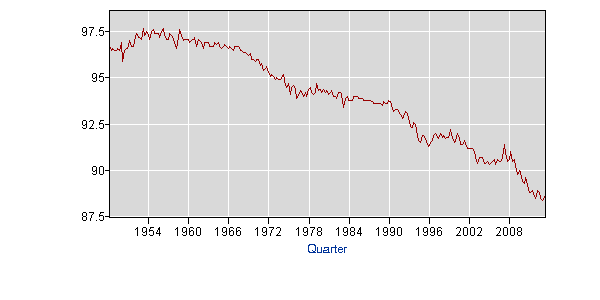
The situation of prime-age black men is even
worse [see below]. Starting at about 90% in 1972, when reporting
of these data began, down to 89% in 1979, then 87.5 in 1990. The
rate slipped below 84% in 2001 and slid precipitously from 2009,
ending in August 2013 at 80.6%, also close to a postwar minimum.
It is telling that the rate rose for both men of all races and
black men in the late 1990's, when jobs were relatively plentiful.
Labor
Force Participation Rate of Black Men 25-54
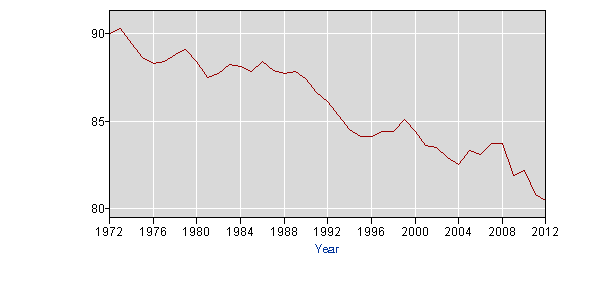
[Data availability for prime-age black men began in 1972.]
AUTHOR'S NOTE: I am dissatisfied
with the data available to find out why prime-age men have dropped
out of the labor force. The hypothesis I'd like to test is that
the major reason is the lack of decent jobs. However, this would
require an accurate count of discouraged workers, which we don't
have. Extensive periods of high unemployment lead to high numbers
of discouraged workers, who are excluded from both official unemployment
rates and the LFPR. Further, getting a count to add them back
in may be impossible. For example, the current measure of discouraged
workers includes only those who have looked for work within the
last year, not those who have been out of the job market for longer
than that.[1] Many former prisoners, disproportionately high-school
dropouts, would be among them, a larger group after the rising
wave of incarceration, which has only recently peaked. This undercount
is especially significant for black workers who have been most
affected by the war on drugs, as ex-prisoners have difficulty
finding employment.[2]
Even worse, some of the early retirement is likely
to be related to work discouragement, as is returning to school,
applying for disability payments, perhaps even exiting for home
care. How can we ever know how many people want jobs until we
are committed to providing a job for everyone who wants one, and
assisting those who need transportation, child care, or a work
place that accommodates a disability? The National Commission
on Employment and Unemployment (1979) decided against including
discouraged workers in the official unemployment count, on the
grounds that "during the upswing..., when opportunities for
work increase, many nonparticipants who are not classified as
discouraged workers also enter the labor force." In fact,
as the Chairman of another commission on labor policy noted, whenever
there are plenty of good jobs available, "millions of people
come out of the woodwork" to take them.[3] The following
analysis is necessarily based on these problematic data.
JOB AVAILABILITY
Looking at the trajectory of the LFPR above provides some support
for the effect of changing job availability. The rate started
sinking in the early 1960's, but the slide accelerated in the
1970's. What began at 96.0% in January 1970 was by December of
1979, 94.3. Further declines in the 1980's and 1990's ended below
90% in December 2008, with the ongoing recession, at least for
job-seekers. Researchers at the Federal Reserve Board conclude
that "analysis of state-level employment data indicates that
cyclical factors[that is, unemployment] can
fully account for the post-2007 decline of 2 percentage points
in the LFPR for prime-age adults (that is, 25 to 54 years old)."
However, their conclusion differs for its long-term secular decline.[4]
The aharp
change in the unemployment rate for prime-age men in the recessions
of 1973-5, 1981-2, and 2007-9 must have been a special shock [second
chart].
UNEMPLOYMENT
RATE, MEN 25-54 (seasonally adjusted)
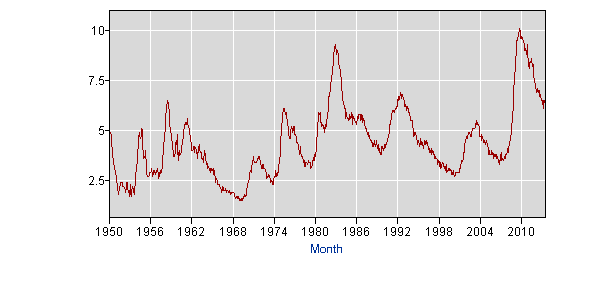 0 0
Chart
below shows change in the unemployment rate for prime-age
men:
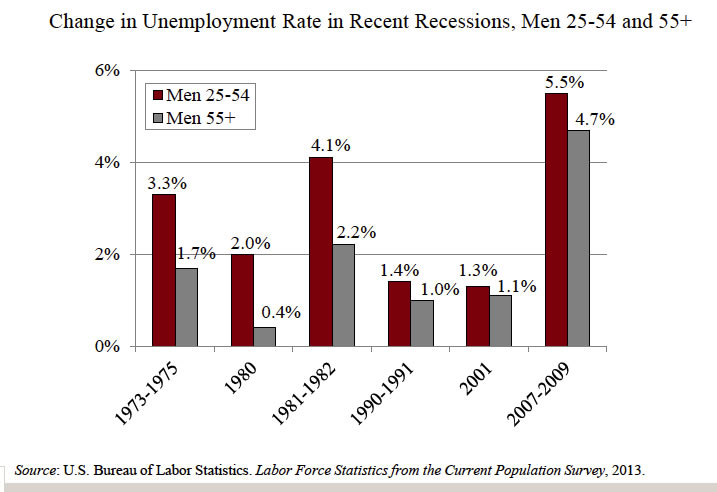
Per
Cent of Men 25-54 with Jobs

Job availability is limited, especially for those without college
degrees. However, though some jobs require college training, many
college graduates are doing jobs that could be done by those with
less training. This bumping occurs when jobs are in short supply.
The pre-crisis expansion of 2000-2007 was accompanied by the weakest
job expansion in decades. See also Missing Men in U.S. Workforce Risk Permanent Separation By Kasia Klimasinska, Bloomberg, Sep 18, 2014
This is not the inevitable result of globalization
and technology. It is the economic failure of public and private
sectors to create enough spending to put the available labor force
to work .
Jared
Bernstein depicts this failure:
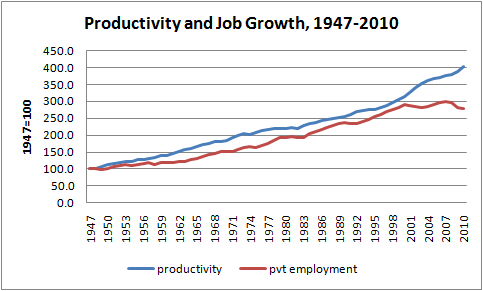
He notes, "since the 2000s, when the split
in last graph begins, the U.S. economy simply hasn't been creating
enough demand to absorb productivity's growth. That been particularly
acute and evident in the recession, of course, but it predates
the downturn, especially, though not exclusively, for prime-age
men." Two MIT professors attribute this disparity to the
job-destroying
effects of advances in computer technology "in law, financial
services, education, and medicine." This may be true, but
whether we have full employment is a political decision. There
are still many tasks to be done, and should we ever run out
of these, we can take earlier retirement or longer vacations or
work shorter hours. The US still has an unenviable record as the
industrial country with
the longest average annual work hours in 2012, longer than the
UK, Australia or Japan, not to mention Scandinavia, and above
the OECD average, which includes Estonia, Mexico, Turkey and other
poorer countries.
Josh
Blivens concludes, "We noted a long time ago that policymakers
seemed to have largely given
up on presenting actual solutions to the jobs-crisis. 2013,
however, is the first year that federal policymakers have succeeded
in setting policy to actively
make it worse, and stomping on some of the first
promising trends in years."
OTHER REASONS FOR THE DECLINE--retirement,
disability, home responsibilties, education, and other
RETIREMENT
THE GOOD NEWS Some of those men
who can't get work retire. In 2012, about 8% [see graph below]
of men 25-54 who left the labor force retired. These men are unlikely
to return when employment improves. Many men who lose jobs in
their 50's can't find another, and are forced to retire. However,
a very small share of this labor force decline is a good sign,
one that indicates that for some few men, there is a financial
possibility of withdrawing from the labor force before old age.
Some workers with a 30-year work life might have started at 18
and be eligible for retirement benefits when they are about 50
years old.
This choice is unlikely for the majority of those
who have withdrawn, and will become even less likely as younger
workers lose the right to employer-provided pensions, especially
those that provide a defined-benefit.
Since 1967, the BLS, through the
Current Population Survey, has asked those who are not in
labor force the reason for their absence. Researchers,
using these data, examined the responses of only those
who were employed or unemployed the previous year, and
so more likely to return.
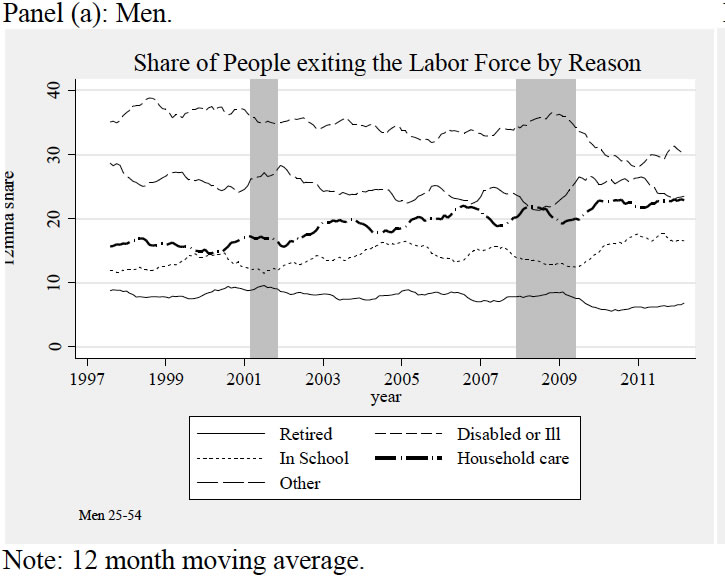
Source: “A
Closer Look at Nonparticipants During and After the Great
Recession,” by Julie L. Hotchkiss, M. Melinda Pitts and
Fernando Rios-Avila. Working paper 2012-10, 8/12, Federal Reserve
Bank of Atlanta.
Illness and Disability
"Labor force participation among prime-age
men has fallen for two main reasons: increased access to Social
Security disability benefits and decreased demand for less-skilled
workers." These are related. As the relative wages of high
school dropouts have declined, disability
benefits have replaced a larger fraction of earned income.
[5] We'll see that this can be debated.
Probably a majority of researchers attribute
the secular decline of the prime male LFPR in part to the availability
of Social Security Disability Insurance. "Expansions
in the...program account for a substantial portion of that decline,
because most individuals who start receiving disability benefits
never reenter the labor force; increased incarceration rates
also appear to have played a significant role. However, those
trends appear to have subsided over the half-decade prior to the
Great Recession...."
The graph above includes only men 25-54. Unfortunately,
it is much harder to read than the one for all workers of that
age, show below under Other.
Some of the evidence used to point to the role
of Disability Insurance is interviews with those who have left
the labor force, as noted above. A plurality of men age 25 to
54 who left the labor force over the last 15 years said they did
so because they were ill or disabled [[about 30% recently:
top line of graph]. Autor
and Duggan point to two changes which encouraged this move:
in 1984, the disability determination was liberalized to cover
depression and severe pain, reversing a major reduction in
numbers on disability. The second occurred because of a rising
replacement rate: disability benefits are both progressive and
indexed to the mean wage. Over the next decades, the ratio of
disability payments to wages rose as the pay and job prospects
of unskilled workers deteriorated. The disability program also
includes Medicare.
Others disagree. "Some of the youngest and
least skilled groups have seen increases in receipt [of disability
insurance], but the
magnitudes are tiny compared with the declines in the employment-population
ratio... ". [6] Or, "after the mid-1990s, we
find little role for the DI program in explaining the continuing
employment decline for men with work limitations."
Other analysis "suggests that other factors
were behind that decline in participation, and that the
growth in D[isability] I[nsurance] rolls experienced in the 1990s
was made up of men who would not have been working regardless
of the DI expansion."
It is also evident that this rate rose with
the recession and has fallen since, as the job market slightly
improved. Research has shown the relevance of job availability:
"The
largest declines [in the LFPR] have occurred in states with the
largest job losses. ...during the downturn and recovery periods
of the recessions of 1981–82, 1990–91, 2001, and 2007–09."
Household Care[graph above]
Though workers with family members who are sick
or otherwise need care face a limited set of options in the US,
it is good news that men are taking on this role in greater numbers
[above, third line up]--rising from 16% of those leaving the labor
force in the late 1990's to about 22% at the end of 2011. Women
continue to have the major burden. This category for both men
and women [the orange line in the graph below, right-hand axis]
included about 47% of all those leaving the labor force in 2011.
Back to School [graph above]
Roughly 17-18% of prime-age men who left the
labor force returned to school [graph above, second line up from
bottom]. Though the upward shift after the recession was most
pronounced for those
with some college or a degree, the shift occurred at all levels
of education. Presumably these men plan to return to work
once they finish schooling and/or find a job.
Other [graph above]
About 22% left for a variety of reasons. They are in the BLS
category of "not in the labor force/currently wants a job." This
would include those who lack transportation, child care, or an
undefined reason, "although
this category may be capturing some of the discouraged workers...
In April 2012, these people accounted for only 1.1 percent of
all nonparticipants (41 percent of the marginally attached—those
who want a job, are available to work, and searched in the previous
year)"
Shaded areas are periods of recession; the right-hand axis measures
the category of those leaving to care for members of their household.
NOTES
[1] "In 1994, the
BLS changed the way in which it counts 'discouraged' workers.....
If one is unemployed for more than 52 weeks, even if one continues
to look for employment, one is dropped from the labor force."
"Between one and two million jobless workers who gave up
their job search after twelve months of frustration are no longer
counted in official figures."
[2] "At
2001 rates, 6.6% of the population and 17% of men will be incarcerated
in State or Federal prison during their lives..." "Incarceration
disproportionably affects males under 35, African Americans, and
the low educated." "...the share of white male school
dropouts who had ever been incarcerated rose from 14.4 percent
in 1999 to 28.0 percent in 2009; the rate for black male dropouts
rose from 46 percent to 68 percent." http://www.brookings.edu/~/media/Projects/BPEA/Fall
2012/2012b_Moffitt.pdf
[3] Helen Ginsburg, Full Employment and Public
Policy: the US and Sweden, Lexington Books, 1983, pp.30-31.
She quotes from A.H.Raskin, NY Times, 2/15/76:
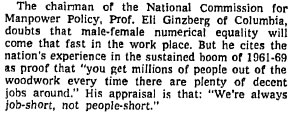
[4] "Expansions in the Social Security Disability
Insurance program account for a substantial portion of that decline
[of the prime-male LFPR from 1940's to the 2000's], because most
individuals who start receiving disability benefits never reenter
the labor force; increased incarceration rates also appear to
have played a significant role. However, those trends appear to
have subsided over the half-decade prior to the Great Recession;
that is, the LFPR for prime-age males was stable at around 90.5
percent from 2003 to 2007." http://www.bostonfed.org/employment2013/papers/Erceg_Levin_Session1.pdf
[5] "Many
prime-age men who leave the labor force during downturns stay
out even after the economy recovers, although not to the same
extent as teenagers. The weak cyclical recoveries of the
labor force participation rate of prime-age men are related to
a secular decline."
[6]
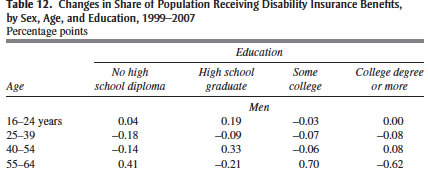
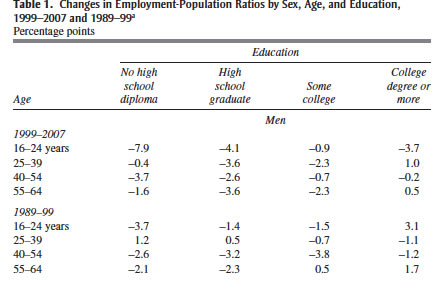
|

